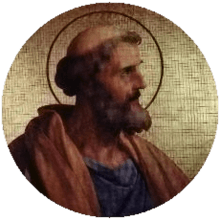Pope Celestine I
| Pope Saint Celestine I | |
|---|---|
 | |
| Papacy began | 10 September 422 |
| Papacy ended | 26 July 432 |
| Predecessor | Boniface I |
| Successor | Sixtus III |
| Personal details | |
| Birth name | Celestine |
| Born | Rome, Western Roman Empire |
| Died | 26 July 432 |
| Sainthood | |
| Feast day |
|
| Venerated in | |
| Attributes |
|
| Other popes named Celestine | |
| Papal styles of Pope Celestine I | |
|---|---|
 | |
| Reference style | Our Holiness |
| Spoken style | Your Holiness |
| Religious style | Holy Father |
| Posthumous style | Saint |
Pope Celestine I (Latin: Caelestinus I; died 26 July 432) was Pope from 10 September 422 to his death in 432.[1] According to the Liber Pontificalis, the start of his papacy was 3 November.[2] However, Tillemont places the date at 10 September.[3]
Biography
Celestine I was a Roman from the region of Campania.[2] Nothing is known of his early history except that his father's name was Priscus. He is said to have lived for a time at Milan with St. Ambrose. The first known record of him is in a document of Pope Innocent I from the year 416, where he is spoken of as "Celestine the Deacon".[1]
Various portions of the liturgy are attributed to him, but without any certainty on the subject. Though he did not attend personally, he sent delegates to the First Council of Ephesus of 431, in which the Nestorians were condemned. Four letters written by him on that occasion, all dated 15 March 431, together with a few others, to the African bishops, to those of Illyria, of Thessalonica, and of Narbonne, are extant in re-translations from the Greek; the Latin originals having been lost.
St. Celestine actively condemned the Pelagians and was zealous for Roman orthodoxy. He sent Palladius to Ireland to serve as a bishop in 431. Bishop Patricius (Saint Patrick) continued this missionary work. Pope Celestine strongly opposed the Novatians in Rome; as Socrates Scholasticus writes, "this Celestinus took away the churches from the Novatians at Rome also, and obliged Rusticula their bishop to hold his meetings secretly in private houses."[4] He was zealous in refusing to tolerate the smallest innovation on the constitutions of his predecessors. As St. Vincent of Lerins reported in 434:
- Holy Pope Celestine also expresses himself in like manner and to the same effect. For in the Epistle which he wrote to the priests of Gaul, charging them with connivance with error, in that by their silence they failed in their duty to the ancient faith, and allowed profane novelties to spring up, he says: "We are deservedly to blame if we encourage error by silence. Therefore rebuke these people. Restrain their liberty of preaching."[5]
In a letter to certain bishops of Gaul, dated 428, St. Celestine rebukes the adoption of special clerical garb by the clergy. He wrote: "We [the bishops and clergy] should be distinguished from the common people [plebe] by our learning, not by our clothes; by our conduct, not by our dress; by cleanness of mind, not by the care we spend upon our person" [1]
St. Celestine died on 26 July 432. He was buried in the cemetery of St. Priscilla in the Via Salaria, but his body, subsequently moved, now lies in the Basilica di Santa Prassede.
In art, Saint Celestine is portrayed as a Pope with a dove, dragon, and flame, and is recognized by the Church as a saint.
See also
References
- 1 2 3
 Herbermann, Charles, ed. (1913). "Pope St. Celestine I". Catholic Encyclopedia. New York: Robert Appleton Company.
Herbermann, Charles, ed. (1913). "Pope St. Celestine I". Catholic Encyclopedia. New York: Robert Appleton Company. - 1 2 Loomis, Louise Ropes (1916). The Book of the Popes (Liber Pontificalis). New York: Columbia University Press. pp. 92f.
- ↑ Tillemont, Louis Sébastien Le Nain de (1709). Memoires pour servir a l'histoire ecclesiaástique des six premiers siécles. Paris: Charles Robustel. pp. 14:148.
- ↑ "Ecclesiastical History 7:11". Retrieved 3 March 2012.
- ↑ Lerins, St. Vincent of. "Commonitory 32". Retrieved 12 July 2011.
External links
| Wikimedia Commons has media related to Coelestinus I. |
| Wikisource has the text of the 1911 Encyclopædia Britannica article Celestine (popes). |
| Titles of the Great Christian Church | ||
|---|---|---|
| Preceded by Boniface I |
Pope 422–432 |
Succeeded by Sixtus III |

